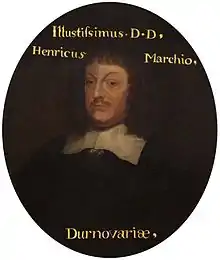Henry Pierrepont, 1st Marquess of Dorchester
Henry Pierrepont, 1st Marquess of Dorchester, PC, FRS, FRCP (March 1606 – 8 December 1680) was an English peer. He was the son of Robert Pierrepont, 1st Earl of Kingston-upon-Hull, and his wife, the former Gertrude Talbot, daughter of George Talbot and Elizabeth Reyner, and cousin of the Earl of Shrewsbury.


Career
Styled Viscount Newark from 1628, he was Member of Parliament for Nottingham[1] from 1628 until 1629, and was summoned to the House of Lords[2] in his father's Barony of Pierrepont in 1641. He succeeded his father as 2nd Earl of Kingston-upon-Hull in 1643.[2]
During the earlier part of the English Civil War he was at Oxford in attendance upon the King, whom he represented at the negotiations at Uxbridge. In 1645 he was made a Privy Counsellor and created Marquess of Dorchester; but in 1647 he compounded for his estates by paying a large fine to the parliamentarians.[1] Afterwards, Lord Dorchester, who was always fond of books, spent his time mainly in London engaged in the study of medicine and law, his devotion to the former science bringing upon him a certain amount of ridicule and abuse.[1] His collection of books is now part of the library of the Royal College of Physicians.
In 1658 he was made a Fellow of the College of Physicians. After the Restoration he was restored to the Privy Council, and was made Recorder of Nottingham and a Fellow of the Royal Society.[2]
Personality
He was notorious for his bad temper and violent outbursts. He challenged his son-in-law, the future Duke of Rutland, to a duel in 1660; Dorchester blamed Rutland for the fact that his marriage to Dorchester's daughter Anne was notoriously unhappy. In 1638 he had to sue for a royal pardon for an assault on one Philip Kinder committed within the precincts of Westminster Abbey, during a religious service. In 1666, on a trivial pretext, he and George Villiers, 2nd Duke of Buckingham, came to blows in the Painted Chamber at Westminster during a Parliamentary conference. They were both imprisoned in the Tower of London for violating the dignity of Parliament as a result, but they were soon released after apologising.[3]
Marriages and children
He married first Cecilia Bayning, a daughter of Paul Bayning, 1st Viscount Bayning, and his wife Anne Glemham, daughter of Sir Henry Glemham. They had four children:
- Lady Anne Pierrepont (born 9 March 1630), married John Manners, future Duke of Rutland. In an unprecedented step, Manners was granted a divorce by an Act of Parliament in 1670.
- Grace Pierrepont.
- Henry Pierrepont (died 1649).
- Robert Pierrepont.
He was secondly married to Lady Catherine Stanley, a daughter of James Stanley, 7th Earl of Derby and Charlotte Stanley, Countess of Derby. This marriage was childless.
Dorchester survived his sons and when he died in London on 8 December 1680 the Marquessate of Dorchester became extinct. He was succeeded as 3rd Earl of Kingston-upon-Hull by Robert (died 1682), a son of Robert Pierrepont of Thoresby, Nottinghamshire, and as 4th Earl by Robert's brother William (died 1690).[1]
References
-
 One or more of the preceding sentences incorporates text from a publication now in the public domain: Chisholm, Hugh, ed. (1911). "Kingston-upon-Hull, Earls and Dukes of". Encyclopædia Britannica. 15 (11th ed.). Cambridge University Press. p. 821.
One or more of the preceding sentences incorporates text from a publication now in the public domain: Chisholm, Hugh, ed. (1911). "Kingston-upon-Hull, Earls and Dukes of". Encyclopædia Britannica. 15 (11th ed.). Cambridge University Press. p. 821. - Firth, Charles Harding (1896). . In Lee, Sidney (ed.). Dictionary of National Biography. 45. London: Smith, Elder & Co.
- Diary of Samuel Pepys 19 December 1666
| Parliament of England | ||
|---|---|---|
| Preceded by Sir Gervase Clifton John Byron |
Member of Parliament for Nottingham 1628–1629 With: Sir Charles Cavendish |
Succeeded by Parliament suspended until 1640 |
| Peerage of England | ||
| New creation | Marquess of Dorchester 1st creation 1645–1680 |
Extinct |
| Preceded by Robert Pierrepont |
Earl of Kingston-upon-Hull 1643–1680 |
Succeeded by Robert Pierrepont |
| Baron Pierrepont (writ in acceleration) 1st creation 1641–1680 | ||